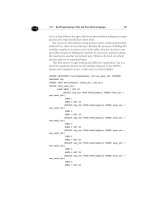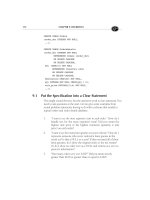sql programming style - apr 2005
Bạn đang xem bản rút gọn của tài liệu. Xem và tải ngay bản đầy đủ của tài liệu tại đây (1.7 MB, 237 trang )
JOE CELKO’S
SQL PROGRAMMING STYLE
JOE CELKO’S
SQL PROGRAMMING STYLE
Joe Celko
Publishing Director Michael Forster
Publisher Diane Cerra
Publishing Services Manager Andre Cuello
Senior Production Editor George Morrison
Editorial Assistant Asma Stephan
Cover Design Side by Side Studios
Cover Image Side by Side Studios
Composition Multiscience Press, Inc.
Copyeditor Multiscience Press, Inc.
Proofreader Multiscience Press, Inc.
Indexer Multiscience Press, Inc.
Interior printer The Maple-Vail Book Manufacturing Group
Cover printer Phoenix Color Corp.
Morgan Kaufmann Publishers is an imprint of Elsevier.
500 Sansome Street, Suite 400, San Francisco, CA 94111
This book is printed on acid-free paper.
© 2005 by Elsevier Inc. All rights reserved.
Designations used by companies to distinguish their products are often claimed as
trademarks or registered trademarks. In all instances in which Morgan Kaufmann
Publishers is aware of a claim, the product names appear in initial capital or all capital
letters. Readers, however, should contact the appropriate companies for more complete
information regarding trademarks and registration.
No part of this publication may be reproduced, stored in a retrieval system, or
transmitted in any form or by any means-electronic, mechanical, photocopying,
scanning, or otherwise-without prior written permission of the publisher.
Permissions may be sought directly from Elsevier’s Science & Technology Rights
Department in Oxford, UK: phone: (+44) 1865 843830, fax: (+44) 1865 853333, e-mail:
You may also complete your request on-line via the
Elsevier homepage () by selecting “Customer Support” and then
“Obtaining Permissions.”
Library of Congress Cataloging-in-Publication Data
Application submitted.
ISBN: 0-12-088797-5
For information on all Morgan Kaufmann publications,
visit our Web site at www.mkp.com or www.books.elsevier.com
Printed in the United States of America
05 06 07 08 5 4 3 2 1
To Eve Astrid Andersson, Miss American
π
And April Wilson, who rubs me the right way.
CONTENTS
Introduction xv
1
Names and Data Elements 1
1.1 Names 2
1.1.1 Watch the Length of Names 2
1.1.2 Avoid All Special Characters in Names 3
1.1.3 Avoid Quoted Identifiers 4
1.1.4 Enforce Capitalization Rules to Avoid
Case-Sensitivity Problems 6
1.2 Follow the ISO-11179 Standards Naming Conventions 7
1.2.1 ISO-11179 for SQL 8
1.2.2 Levels of Abstraction 9
1.2.3 Avoid Descriptive Prefixes 10
1.2.4 Develop Standardized Postfixes 12
1.2.5 Table and View Names Should Be Industry Standards,
Collective, Class, or Plural Nouns 14
1.2.6 Correlation Names Follow the Same Rules as Other
Names . . . Almost 15
1.2.7 Relationship Table Names Should Be Common
Descriptive Terms 17
1.2.8 Metadata Schema Access Objects Can Have Names That
Include Structure Information 18
1.3 Problems in Naming Data Elements 18
1.3.1 Avoid Vague Names 18
1.3.2 Avoid Names That Change from Place to Place 19
1.3.3 Do Not Use Proprietary Exposed Physical Locators 21
2
Fonts, Punctuation, and Spacing 23
2.1 Typography and Code 23
2.1.1 Use Only Upper- and Lowercase Letters, Digits, and
Underscores for Names 25
2.1.2 Lowercase Scalars Such as Column Names, Parameters,
and Variables 25
viii
CONTENTS
2.1.3 Capitalize Schema Object Names 26
2.1.4 Uppercase the Reserved Words 26
2.1.5 Avoid the Use of CamelCase 29
2.2 Word Spacing 30
2.3 Follow Normal Punctuation Rules 31
2.4 Use Full Reserved Words 33
2.5 Avoid Proprietary Reserved Words if a Standard Keyword Is
Available in Your SQL Product 33
2.6 Avoid Proprietary Statements if a Standard Statement Is Available 34
2.7 Rivers and Vertical Spacing 37
2.8 Indentation 38
2.9 Use Line Spacing to Group Statements 39
3
Data Declaration Language 41
3.1 Put the Default in the Right Place 41
3.2 The Default Value Should Be the Same Data
Type as the Column 42
3.3 Do Not Use Proprietary Data Types 42
3.4 Place the PRIMARY KEY Declaration at the Start of the
CREATE TABLE Statement 44
3.5 Order the Columns in a Logical Sequence and Cluster Them
in Logical Groups 44
3.6 Indent Referential Constraints and Actions under the Data Type 45
3.7 Give Constraints Names in the Production Code 46
3.8 Put CHECK() Constraint Near what they Check 46
3.8.1 Consider Range Constraints for Numeric Values 47
3.8.2 Consider LIKE and SIMILAR TO Constraints for
Character Values 47
3.8.3 Remember That Temporal Values Have Duration 48
3.8.4 REAL and FLOAT Data Types Should Be Avoided 48
3.9 Put Multiple Column Constraints as Near to Both Columns
as Possible 48
3.10 Put Table-Level CHECK() Constraints at the End of the
Table Declaration 49
3.11 Use CREATE ASSERTION for Multi-table Constraints 49
CONTENTS
ix
3.12 Keep CHECK() Constraints Single Purposed 50
3.13 Every Table Must Have a Key to Be a Table 51
3.13.1 Auto-Numbers Are Not Relational Keys 52
3.13.2 Files Are Not Tables 53
3.13.3 Look for the Properties of a Good Key 54
3.14 Do Not Split Attributes 62
3.14.1 Split into Tables 63
3.14.2 Split into Columns 63
3.14.3 Split into Rows 65
3.15 Do Not Use Object-Oriented Design for an RDBMS 66
3.15.1 A Table Is Not an Object Instance 66
3.15.2 Do Not Use EAV Design for an RDBMS 68
4
Scales and Measurements 69
4.1 Measurement Theory 69
4.1.1 Range and Granularity 71
4.1.2 Range 72
4.1.3 Granularity, Accuracy, and Precision 72
4.2 Types of Scales 73
4.2.1 Nominal Scales 73
4.2.2 Categorical Scales 73
4.2.3 Absolute Scales 74
4.2.4 Ordinal Scales 74
4.2.5 Rank Scales 75
4.2.6 Interval Scales 76
4.2.7 Ratio Scales 76
4.3 Using Scales 77
4.4 Scale Conversion 77
4.5 Derived Units 79
4.6 Punctuation and Standard Units 80
4.7 General Guidelines for Using Scales in a Database 81
5
Data Encoding Schemes 83
5.1 Bad Encoding Schemes 84
5.2 Encoding Scheme Types 86
x
CONTENTS
5.2.1 Enumeration Encoding 86
5.2.2 Measurement Encoding 87
5.2.3 Abbreviation Encoding 87
5.2.4 Algorithmic Encoding 88
5.2.5 Hierarchical Encoding Schemes 89
5.2.6 Vector Encoding 90
5.2.7 Concatenation Encoding 91
5.3 General Guidelines for Designing Encoding Schemes 92
5.3.1 Existing Encoding Standards 92
5.3.2 Allow for Expansion 92
5.3.3 Use Explicit Missing Values to Avoid NULLs 92
5.3.4 Translate Codes for the End User 93
5.3.5 Keep the Codes in the Database 96
5.4 Multiple Character Sets 97
6
Coding Choices 99
6.1 Pick Standard Constructions over
Proprietary Constructions100
6.1.1 Use Standard OUTER JOIN Syntax 101
6.1.2 Infixed INNER JOIN and CROSS JOIN Syntax
Is Optional, but Nice 105
6.1.3 Use ISO Temporal Syntax 107
6.1.4 Use Standard and Portable Functions 108
6.2 Pick Compact Constructions over Longer Equivalents 109
6.2.1 Avoid Extra Parentheses 109
6.2.2 Use CASE Family Expressions 110
6.2.3 Avoid Redundant Expressions 113
6.2.4 Seek a Compact Form 114
6.3 Use Comments 118
6.3.1 Stored Procedures 119
6.3.2 Control Statement Comments 119
6.3.3 Comments on Clause 119
6.4 Avoid Optimizer Hints 120
6.5 Avoid Triggers in Favor of DRI Actions 120
6.6 Use SQL Stored Procedures 122
CONTENTS
xi
6.7 Avoid User-Defined Functions and Extensions inside the Database 123
6.7.1 Multiple Language Problems 124
6.7.2 Portability Problems 124
6.7.3 Optimization Problems 124
6.8 Avoid Excessive Secondary Indexes 124
6.9 Avoid Correlated Subqueries 125
6.10 Avoid UNIONs 127
6.11 Testing SQL 130
6.11.1 Test All Possible Combinations of NULLs 130
6.11.2 Inspect and Test All CHECK() Constraints 130
6.11.3 Beware of Character Columns 131
6.11.4 Test for Size 131
7
How to Use VIEWS 133
7.1 VIEW Naming Conventions Are the Same as Tables 135
7.1.1 Always Specify Column Names 136
7.2 VIEWs Provide Row- and Column-Level Security 136
7.3 VIEWs Ensure Efficient Access Paths 138
7.4 VIEWs Mask Complexity from the User 138
7.5 VIEWs Ensure Proper Data Derivation 139
7.6 VIEWs Rename Tables and/or Columns 140
7.7 VIEWs Enforce Complicated Integrity Constraints 140
7.8 Updatable VIEWs 143
7.8.1 WITH CHECK OPTION clause 143
7.8.2 INSTEAD OF Triggers 144
7.9 Have a Reason for Each VIEW 144
7.10 Avoid VIEW Proliferation 145
7.11 Synchronize VIEWs with Base Tables 145
7.12 Improper Use of VIEWs 146
7.12.1 VIEWs for Domain Support 146
7.12.2 Single-Solution VIEWs 147
7.12.3 Do Not Create One VIEW Per Base Table 148
7.13 Learn about Materialized VIEWs 149
xii
CONTENTS
8
How to Write Stored Procedures 151
8.1 Most SQL 4GLs Are Not for Applications 152
8.2 Basic Software Engineering 153
8.2.1 Cohesion 153
8.2.2 Coupling 155
8.3 Use Classic Structured Programming 156
8.3.1 Cyclomatic Complexity 157
8.4 Avoid Portability Problems 158
8.4.1 Avoid Creating Temporary Tables 158
8.4.2 Avoid Using Cursors 159
8.4.3 Prefer Set-Oriented Constructs to
Procedural Code 161
8.5 Scalar versus Structured Parameters 167
8.6 Avoid Dynamic SQL 168
8.6.1 Performance 169
8.6.2 SQL Injection 169
9
Heuristics 171
9.1 Put the Specification into a Clear Statement 172
9.2 Add the Words “Set of All…” in Front of the Nouns 173
9.3 Remove Active Verbs from the Problem Statement 174
9.4 You Can Still Use Stubs 174
9.5 Do Not Worry about Displaying the Data 176
9.6 Your First Attempts Need Special Handling 177
9.6.1 Do Not Be Afraid to Throw Away Your First
Attempts at DDL 177
9.6.2 Save Your First Attempts at DML 178
9.7 Do Not Think with Boxes and Arrows 179
9.8 Draw Circles and Set Diagrams 179
9.9 Learn Your Dialect 180
9.10 Imagine That Your WHERE Clause Is “Super Ameba” 180
9.11 Use the Newsgroups and Internet 181
10
Thinking in SQL 183
10.1 Bad Programming in SQL and Procedural Languages 184
CONTENTS
xiii
10.2 Thinking of Columns as Fields 189
10.3 Thinking in Processes, Not Declarations 191
10.4 Thinking the Schema Should Look Like the Input Forms 194
Resources 197
Military Standards 197
Metadata Standards 197
ANSI and ISO Standards 198
U.S. Government Codes 199
Retail Industry 199
Code Formatting and Naming Conventions 200
Bibliography 203
Reading Psychology 203
Programming Considerations 204
Index 207
About the Author 217
Introduction
I
AM NOT trying to teach you to program in SQL in this book. You might
want to read that again. If that is what you wanted, there are better
books. This ought to be the second book you buy, not the first.
I assume that you already write SQL at some level and want to get
better at it. If you want to learn SQL programming tricks, get a copy of
my other book,
SQL for Smarties
(3rd edition, 2005). I am trying to
teach the reader how to work in logical and declarative terms, instead
of in a procedural or OO manner—“Query Eye for the Database Guy,”
if you will forgive a horrible contemporary pun.
Few, if any, SQL programmers came to SQL before learning and
writing for years in a procedural or object-oriented language. They
then got one particular SQL product and were told to learn it on their
own or with a book that has a title like “SQL for Brain-Dead Morons,”
“Learn SQL in Ten Easy Lessons or Five Hard Ones,” or worse.
This is absurd! It takes at least five years to learn to be a master
carpenter or chef. Why would you believe people could become SQL
gurus in a weekend? What they become is bad SQL programmers, who
speak SQL in dialect from the local SQL product with a strong accent
from their previous languages. You might want to read “Teach Yourself
Programming in Ten Years” by Peter Norvig (www.norvig.com/21-
days.html) or “No Silver Bullets” by Fred Brooks,
Computer
, 20(4):10-
19, April 1987) to get a reality check.
xvi INTRODUCTION
The horrible part is that these people often don’t know they are bad
programmers. At one extreme, the entire shop where they work is just as
bad, and they never see anything else. At the other extreme, if anyone
tries to tell them about their problems, they become defensive or angry.
If you look at postings on SQL newsgroups, many programmers just
want to get a kludge for an immediate problem and not actually obtain a
true long-term solution.
If these were woodworking newsgroups, their questions would be the
equivalent of “What are the best kind of rocks to use to pound screws
into fine furniture?” When someone tells them to use large chunks of
granite, they are happy, but if you try to tell them about screwdrivers,
they explode into a rage.
You might want to read an essay on this phenomenon: “Unskilled and
Unaware of It: How Difficulties in Recognizing One’s Own Incompetence
Lead to Inflated Self-Assessments” by Justin Kruger and David Dunning
(Department of Psychology, Cornell University, www.apa.org/journals/
psp/psp7761121.html).
Or look at the actual and self-assessments of American high school
students in mathematics and sciences that were part of the Bush
administration’s No Child Left Behind Act.
1.1 Purpose of the Book
So how did we old farts learn to be better programmers when dinosaurs
walked the earth? One of the best helpers we had in the late 1970s when
the structured programming revolution came along was a series of books
entitled “[Pascal | FORTRAN | COBOL | BASIC] with Style: Programming
Proverbs” by Henry Ledgard and some of his colleagues at MIT. The
covers were done like a Victorian novel with angels, scrolls, and old-style
typographical elements. And like a Victorian novel, the books were
subtitled “Principles of Good Programming with Numerous Examples to
Improve Programming Style and Proficiency.” These books and others
made a big difference for most of us because they taught us how to think
like good programmers.
My goals in this book are to improve SQL programming style and
proficiency. To be more exact:
1.
To help an individual programmer write Standard SQL without an
accent or a dialect
. It is difficult to unlearn old habits but not
impossible, and it is best to learn the right way from the start.
Amateurs write code for themselves. A professional writes code
1.2 Acknowledgments xvii
to be maintained and used by other people. My rule of thumb
has been that you need to have a full year of SQL programming
before you have your epiphany and suddenly see the world in
three: valued logic, data models, and sets.
2.
To give an SQL shop a coding standard for internal use
. I have
tried carefully to give a rationale for each of my rules, and I
have given exceptions to those rules when I could think of
them. You may disagree with some of my choices, but you will
have to provide research and examples to defend your position.
It is not good enough to simply declare: “Well, that’s the way
we wrote code in FooTran,
so it must be the will of God!” as an
argument.
If you are the team leader, you now have a book (and
author) that you can hold up and blame for anything that your
people do not like. Even if I am later shown to be wrong about
something, you will have been consistent. It is much easier to
repair errors if they were made consistently.
3.
To give programmers the mental tools to approach a new problem
with SQL as their tool
. I tell people it takes about a year to “get it”
and drop your procedural programming habits.
1.2 Acknowledgments
Craig Mullins provided the structure of the chapter on VIEWs in an
article in www.DBAzine.com. The formatting style is taken from a house
style I have used in CMP magazines and other publications for more
than a decade. Peter Gulutzan provided the data for the naming
conventions in actual products from an article in www.DBAzine.com.
The affix conventions in Chapter 1 are based on internal standards from
Teradata Corporation. The scales and measurements and the encoding
schemes material appeared in several of my old magazine columns in
DBMS
and
Database Programming & Design
before they were collected
into a chapter in my book
Data & Database
(Morgan-Kaufmann
Publishers). I have tried to give credit in the text, but so many people
have participated in the newsgroups over the years that I know I am
forgetting someone.
And, obviously, thanks to Henry Ledgard and his “Programming
Proverbs” series for the inspiration.
I would also like to thank all of the newbie programmers who wrote
bad code. It sounds a bit sarcastic, but it is not meant to be. Many of the
xviii INTRODUCTION
newbies are programmers who were thrown into a DBA or SQL
programmer job by management without training or an experienced
mentor. I do not want to blame the victims unless they are really not
working on getting better. Your errors in syntax, semantics, and style
showed me how you were thinking. Diagnosis is the first step to
treatment.
1.3 Corrections, Comments, and Future Editions
Corrections and additions for future editions can be sent to Morgan-
Kaufmann publishers directly or to me at my e-mail address,
CHAPTER
1
Names and Data Elements
This is the old joke:
“When I was a kid, we had three cats.”
“What were their names?”
“Cat, cat, and cat.”
“That sounds screwed up. How did you tell them apart?”
“Who cares? Cats don’t come when you call them anyway!”
Y
OUR
DATA
WILL
not come when it is called either if you do not give it a
name that is always distinct and recognizable. This is an important
part of any database project. Bad names for the data elements make
the code difficult, or even impossible, to read.
I am not kidding about impossible to read. In the old days,
software companies used to deliberately scramble source code names
and remove formatting to hide the algorithm from the buyers. The
tradition seems to linger on, even if not by intent. In August 2004, a
SQL newsgroup had a posting in which all of the names were one
letter and a long string of digits.
There are now ISO-11179 metadata standards that describe rules
for naming data elements and for registering standards. Because they
are an ISO standard, they are what you should be using in SQL as well
as everywhere else.
That standard, a bit of typography, and some common sense will
give you the rules you need to get started.
2 CHAPTER 1: NAMES AND DATA ELEMENTS
1.1 Names
In the early days, every programmer had his or her own personal
naming conventions. Unfortunately, they were often highly creative. My
favorite was a guy who picked a theme for his COBOL paragraph names:
one program might use countries, another might use flowers, and so
forth. This is obviously weird behavior even for a programmer, but many
programmers had personal systems that made sense to themselves but
not to other people.
For example, the first FORTRAN I used allowed only six-letter
names, so I became adept at using and inventing six-letter names.
Programmers who started with weakly typed or typeless languages like to
use Hungarian notation (see Leszynski and Reddick). Old habits are
hard to give up.
When software engineering became the norm, every shop developed
its own naming conventions and enforced them with some kind of data
dictionary. Perhaps the most widespread set of rules was MIL STD
8320.1, set up by the U.S. Department of Defense, but it never became
popular outside of the federal government. This was a definite
improvement over the prior nonsystem, but each shop varied quite a bit;
some had formal rules for name construction, whereas others simply
registered whatever the first name given to a data element was.
Today, we have ISO-11179 standards, which are becoming
increasingly widespread, required for certain government work, and
being put into data repository products. Tools and repositories of
standardized encoding schemes are being built to this standard. Given
this and XML as a standard exchange format, ISO-11179 will be the way
that metadata is referenced in the future.
1.1.1 Watch the Length of Names
Rationale:
The SQL-92 standards have a maximum identifier length of 18
characters. This length came from the older COBOL standards. These
days, SQL implementations allow longer names, but if you cannot say it
in 18 characters, then you have a problem. Table 1.1 shows the
maximum length for names of the most important SQL schema objects
according to ISO and several popular SQL products.
1.1 Names 3
The numbers in the table are either bytes or characters. A maximum
character length can be smaller than a maximum byte length if you use a
multibyte character set.
Do not use super-long names. People have to read them, type them,
and print them out. They also have to be able to understand those names
when they look at the code, search for them in the data dictionary, and
so forth. Finally, the names need to be shared in host programs that
might not allow the same maximum length.
But do not go to the other extreme of highly condensed names that
are impossible to read without weeks of study. The old Bachman design
tool was used to build DB2 databases back when column length was
limited to 18 bytes. Sometimes the tool would change the logical
attribute name to a physical column name by removing all of the vowels.
Craig Mullins referred to this as “Bachman having a vowel movement on
my DDL.” This is a bad approach to getting the name to fit within a
smaller number of characters.
Exceptions:
These exceptions would be on a case-by-case basis and probably the
result of legacy systems that had different naming restrictions.
1.1.2 Avoid All Special Characters in Names
Rationale:
Special characters in a name make it difficult or impossible to use the
same name in the database and the host language programs or even to
move a schema to another SQL product.
Table 1.2 shows the characters allowed in names by the standards
and popular SQL products.
Generally, the first character of a name must be a letter, whereas
subsequent characters may be letters, digits, or _ (underscore). Any
database management system (DBMS) might also allow $, #, or @, but
no DBMS allows all three, and in any case the special characters are not
Table 1.1
Identifier lengths
SQL-92 SQL-99 IBM MS SQL Oracle
Column
18 128 30 128 30
Constraint
18 128 18 128 30
Table
18 128 128 128 30
4 CHAPTER 1: NAMES AND DATA ELEMENTS
usable everywhere (Microsoft attaches special meaning to names that
begin with @ or # and Oracle discourages special characters in the
names of certain objects).
But what is a letter? In the original SQL, all letters had to be
uppercase Latin, so there were only 26 choices. Nowadays the repertoire
is more extensive, but be wary of characters outside the Latin-1 character
set for the following reasons:
1.
IBM cannot always recognize a letter
. It just accepts that any
multibyte character except space is a letter and will not attempt
to determine whether it’s uppercase or lowercase.
2.
IBM and Oracle use the database’s character set and so could have a
migration problem with exotic letters
. Microsoft uses Unicode and
so does not have this problem.
Intermediate SQL-92 does not allow an identifier to end in an
underscore. It is also not a good idea to put multiple underscores
together; modern printers make it difficult to count the number of
underscores in a chain.
Exceptions:
None
1.1.3 Avoid Quoted Identifiers
Rationale:
Table 1.2
Identifier character sets
Standard SQL IBM Oracle Microsoft
First
Character
Letter Letter, $#@ Letter Letter, #@
Later
Characters
Letter, Digit, _ Letter, Digit,
$#@_
Letter, Digit,
$#_
Letter, Digit,
#@_
Case
Sensitive?
No No No Optional
Term
Ordinary
identifier
Nonquoted
identifier
Regular
identifier
1.1 Names 5
This feature was added to SQL-92. Its main use has been to alias column
names to make printouts look like reports. This kludge defeats the
purpose of a tiered architecture. Instead, it destroys portability of the
code and invites poorly constructed names. Table 1.3 shows the
characteristics of delimited identifiers.
If you find the character-set restrictions of names onerous, you can
avoid them by putting identifiers inside double quotes. The result is a
delimited identifier (or quoted identifier in Oracle terminology).
Delimited identifiers may start with, and contain, any character. It is a bit
uncertain how one can include the double quote (") character. The
standard way is to double it, as in “Empl""oyees” but that’s not always
documented.
Support for delimited names is nearly universal, with only two major
exceptions: (1) IBM will not allow nonalphanumeric characters for labels
and variable names inside stored procedures, and (2) Microsoft will not
allow quoted identifiers if the QUOTED_IDENTIFIER switch is off. The
reason for the first exception is, perhaps, that IBM converts SQL
procedures into another computer language before compilation.
Suppose you make a table with a delimited identifier, for example:
CREATE TABLE "t" ("column1" INTEGER NOT NULL);
Now try to get that table with a regular identifier, thus:
SELECT column1 FROM t;
Table 1.3
Quoted identifier character sets
Standard SQL IBM Microsoft Oracle
Delimiters
"" "" "" or [ ] ""
First Character
Anything Anything Anything Anything
Later
Characters
Anything Anything Anything Anything
Case Sensitive
Yes Yes Optional Yes
Term
Delimited
identifier
Delimited
identifier
Delimited
identifier
Quoted
identifier
6 CHAPTER 1: NAMES AND DATA ELEMENTS
Will this work? According to the SQL standard, it should not, but
with Microsoft, it might. The reason is case sensitivity, which we discuss
in section 1.1.4.
The quoted identifiers do not work well with hot languages, especially
when they have spaces or special characters. For example, this is a valid
insertion statement:
INSERT INTO Table ([field with space]) VALUES (value);
ADO generates the following code:
INSERT INTO Table (field with space) VALUES (value);
which is a syntax error.
Exceptions:
If you need to communicate a result to someone who cannot read or
understand the properly constructed column names in Latin-1, then use
quoted aliases to format the output. I have done this for Polish and
Chinese speakers.
I also use quoted names inside documentation so that they will
immediately read as the name of a schema object and not a regular word
in the sentence.
The usual reason for this error is that the programmer confuses a data
element name with a display header. In traditional procedural languages,
the data file and the application are in the same tier; in SQL, the database
is totally separate from the front end where the data is displayed.
1.1.4 Enforce Capitalization Rules to Avoid Case-
Sensitivity Problems
Rationale:
Case-sensitivity rules vary from product to product.
Standard SQL, IBM, and Oracle will convert regular identifiers to
uppercase but will not convert delimited identifiers to uppercase. For
Microsoft, the case-sensitivity rule has nothing to do with whether the
name is regular or delimited. Instead, identifiers depend on the default
collation. If the default collation is case insensitive, then t equals T. If it’s
case sensitive, then t does not equal T.
To sum up, there are two case-sensitivity problems. The first is that
the delimited identifier “t” and the regular identifier t differ if one follows









